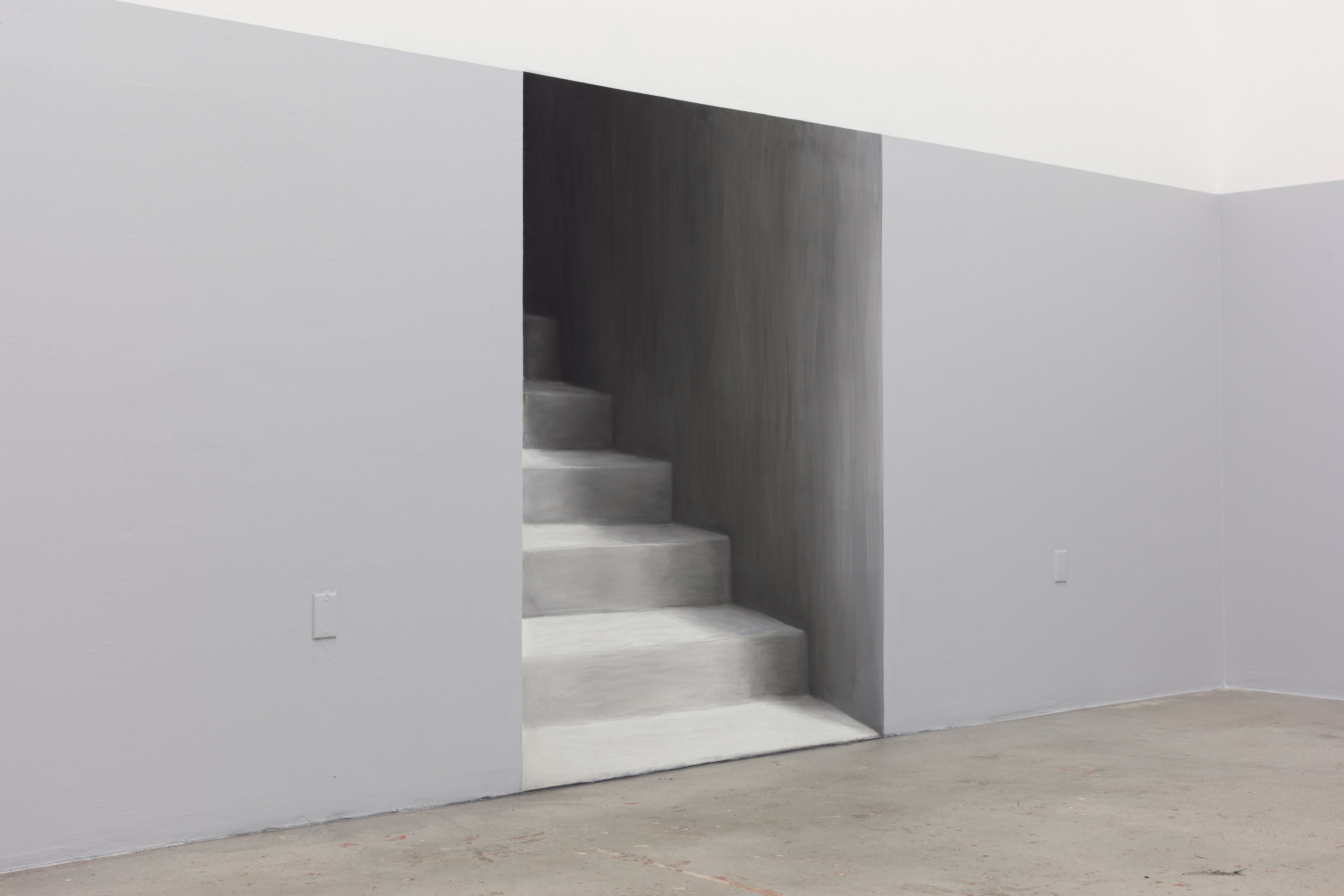Viktor Timofeev, DOG (2021). Installation view at Interstate Projects, New York. Hard pastel, acrylic on wall. Courtesy of Interstate Projects, New York.
The latest in a series of interviews with artists who have a significant body of work that makes use of or responds to network culture and digital technologies.
Elizaveta Shneyderman: Despite being in the same community of NYC, digital-materially focused art Slavs, it wasn’t until I first encountered your installation DOG at Interstate Projects that I had an “aha” moment with your work. The exhibition was effectively robbed of its potential for true interactivity: Chat, your self-playing game, was left to endlessly feed identical responses to increasingly illegible questions. I've noticed this remediation of contemporary sensory experience—as a trope of your work more broadly—has developed in grit and context over the years. What core themes are embedded in these works of procedurally-driven mutation and encryption?
Viktor Timofeev: I'm really glad something clicked! DOG, the installation at Interstate Projects, was my most recent attempt at making an environment evoke something like a discarded interface. I'll break down some of its components. The exhibition centered around a questionnaire program, Chat. Chat was written out in a generative alphabet, a cipher, that made each question progressively harder and more impossible to read. There were two computer terminals, each with a study carrel complete with monitor and keyboard, running the questionnaire program. A large LCD monitor hung in the middle of the room, which visually mimicked the layout of an analog clock, but replaced the twelve-hour numerals with twenty-six letters of the English alphabet. This “alphabet clock” charted the state of each letter forming the words in the questionnaire, and worked as the key to the cipher text. The key was changing at a pace that made it next to impossible to keep up with, mutating one letter per second. The exhibition room also incorporated monochromatic gray walls, a pastel mural of an ascending trompe l'oeil staircase, and five colored pencil drawings.
I wanted to channel the feeling that the installation was already used and abandoned. This led me to introduce a few details that would suggest that someone had already been there, leaving behind traces of participation. Since there were two computer terminals, I conceived of two fictional users—the last ones to have supposedly occupied the space—who had creatively modified the keyboards. One keyboard was jammed, with a small rock tied to the letter “Y” using a worn out shoelace, while the opposing one had all of its keys torn out. This meant that when the questionnaire prompted a response to a question (albeit in an illegible script), one answer would always translate to YYYYYYYYYYYYY and the other to silence. Technically the work was interactive, but the audience didn't get to interact with it—the keyboards were proxy performers. The audience was left with this mise-en-scène arrangement of an aftermath, in which the drawings, the murals, the furniture, the stuttering interaction, and the missing users were part of the same fictional world, same fictional story—a total installation.
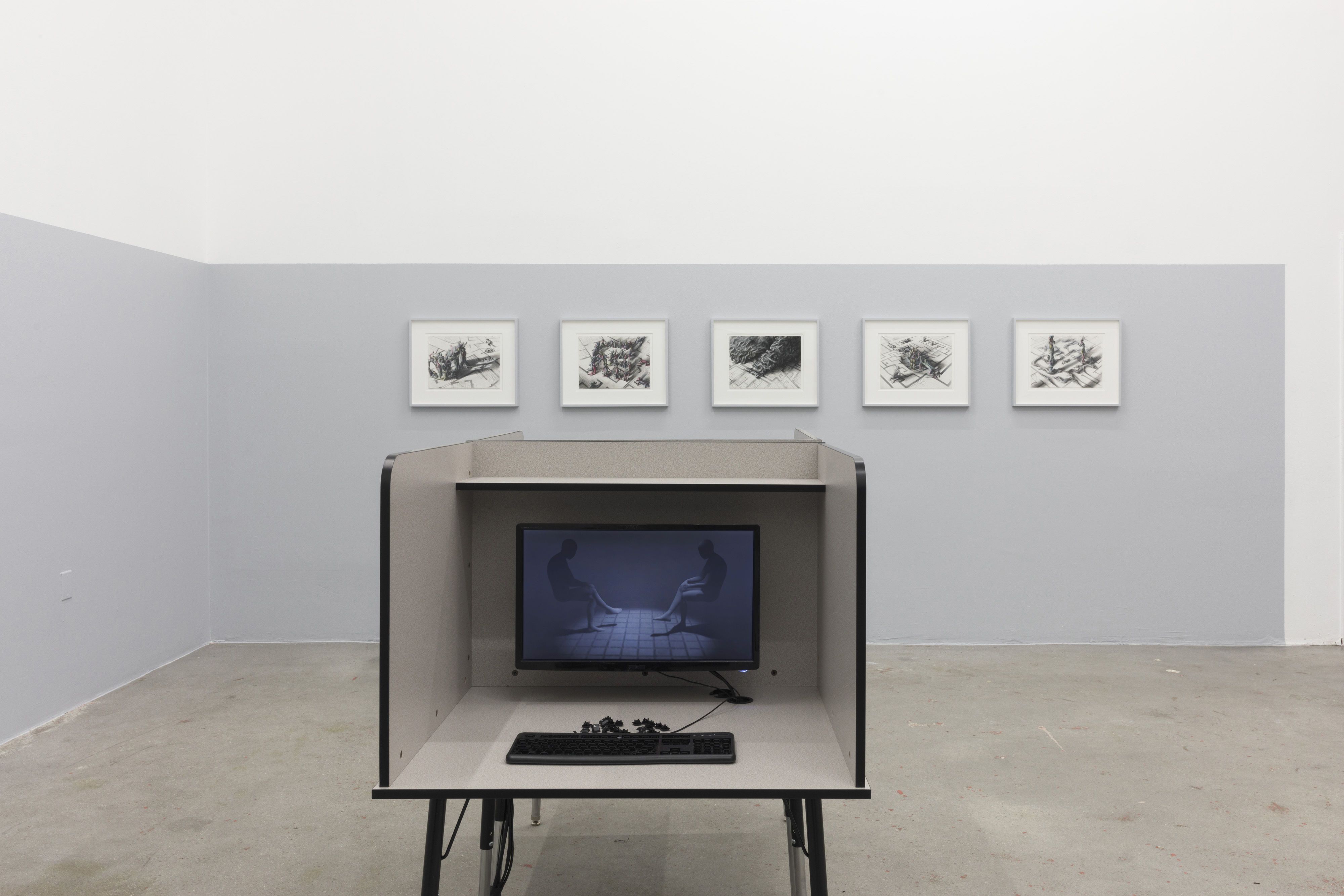
 Viktor Timofeev, DOG (2021). Installation view at Interstate Projects, New York. Three-channel custom software, modified hardware, furniture, coloured pencil on paper. Courtesy of Interstate Projects, New York.
Viktor Timofeev, DOG (2021). Installation view at Interstate Projects, New York. Three-channel custom software, modified hardware, furniture, coloured pencil on paper. Courtesy of Interstate Projects, New York.
All of that said, each attempt at an installation like this has been part of a different exhibition, a different part of the same “Viktor-world,” along an evolutionary journey thinking through the idea of audience participation and the medium of games. The “activated installation” of DOG evolved from self-playing games, which further evolved from games that were played as part of a performance, which further evolved from recording playthrough videos of my first interactive works. In more poetic terms, DOG became about a system that forces participation, in which communication is mandatory, no matter if the language is unknown. It lives in a pedagogically-inclined environment, filled with objects teetering on the edge of legibility and illusion, a threshold crossed only by a pair of anonymous users who rebelled against it and managed to escape. Maybe they disappeared up the staircase drawn on the wall, or into the drawings, joining the other figures that touch, hold and lean on one another as their bodies are jammed together to form human meta-structures seen from above.
ES: Your work addresses this persistent idea—dare I say technocratic fantasy!—that digital and non-language-based practice has a utilitarian function (that is, to supposedly speak to a broad public). Given your own cultural entanglements—particularly being a Russian-speaking Latvian now working in a U.S. context—how do you envision the “public” of your practice given the forms of collective alienation(s) baked into its context?
VT: I think elaborating on this generative alphabet that I mentioned above and how it came to be will definitely connect some of these dots. As I was preparing Proxyah, my first exhibition at Kim? in Riga, Latvia in 2015, I decided to accompany it with a printed set of instructions for a semi-abstract game. It was my first time trying to include a text as part of my exhibited work. I ran into a dead end deciding which languages to use in the guide: Latvian, English, or Russian. You're right, I am a Russian-speaking Latvian and these days a lot of my communication is in English. I also speak Latvian and am the namesake of my grandfather who was a colonel in the Latvian Border Guard. My family roots also go back to Belarus and Baku, Azerbaijan, so like others from post-Soviet states, my language is entangled with Russian.
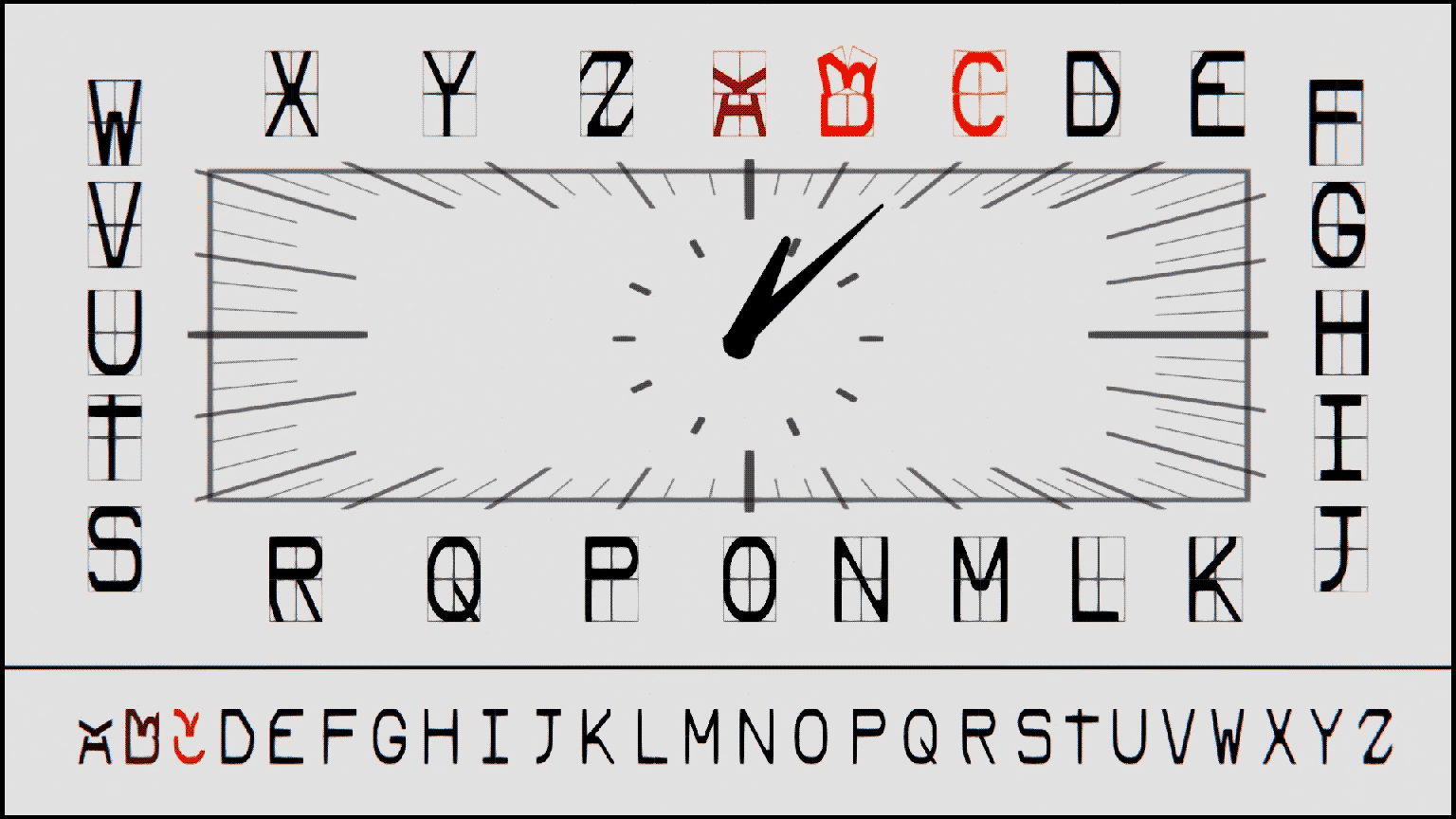 Viktor Timofeev, Human Abecedary (Horizontal Clock version) (2018–21). Custom software, infinite duration. Courtesy of the artist.
Viktor Timofeev, Human Abecedary (Horizontal Clock version) (2018–21). Custom software, infinite duration. Courtesy of the artist.
Trying to circumvent either juggling languages or selecting a single one, I converted the trilingual instructions into pictograms. Mistranslation gave way to ambiguity; no one understood my symbols! So in trying to “universalize” my text, I ended up excluding everyone from it, not just non-speakers. Which, in a way, was unifying. I decided to zoom in on this moving forward and set out to make my own writing system. I had some criteria: it had to use the existing alphabet, it had to exclude my own decision-making as much as possible, and it had to be systematic, pseudo-random, almost infinitely long—a recombinatory process that could generate a vast amount of letter-like glyphs. Keeping track of the original letters would also introduce the idea of translation and encryption, allowing text to be hidden in plain sight.
Basically, I wanted to find a way to defamiliarize the alphabet from itself. I did this by cutting up each letter into quadrants, and reorienting and swapping them around them indefinitely. Essentially the generative alphabet appears “foreign” in the eye of the beholder solely by rearranging parts of itself.
The alphabet, which I have tentatively called Human Abecedary, has gone through several iterations and exhibitions. The project, however, is not yet finished; it's entirely possible that it will mirror the unstable nature of the alphabet itself and be infinitely malleable. But I like that about it—it is an idea that will be living and growing old with me rather than settling into a single, finished state.
So to circle back to your question, the fantasy of tech-driven, universal communication does surface in this work, albeit in an absurd way. By reconnecting letters back to their pictographic roots, Human Abecedary speculates an alternative, evolutionary path. It posits a way to mend linguistic divisions by sharing common ground in the unknowable and celebrating collective alienation.
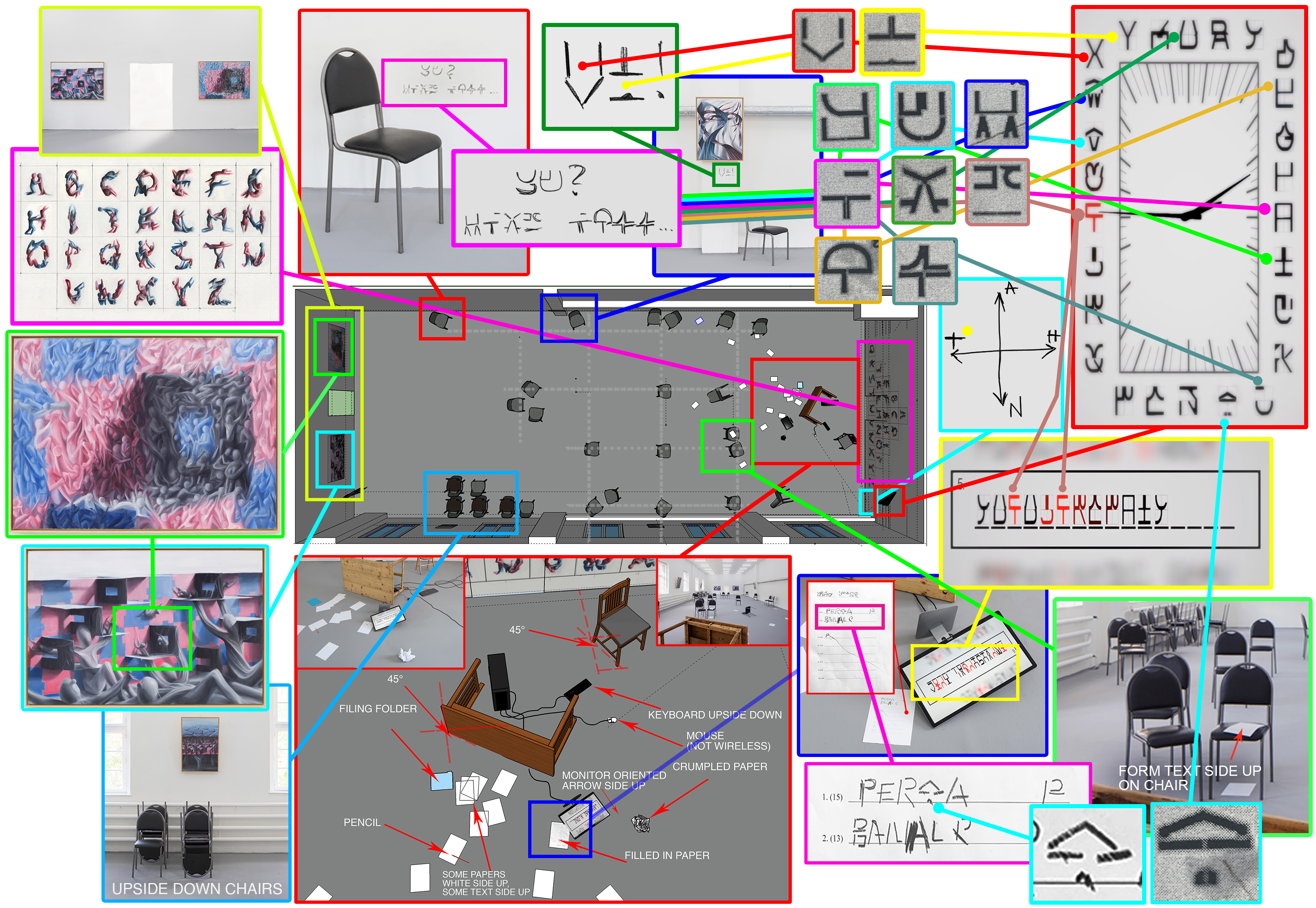 Viktor Timofeev, God Objects (2020). Exhibition map from exhibition at Karlin Studios, Prague. Courtesy of the artist.
Viktor Timofeev, God Objects (2020). Exhibition map from exhibition at Karlin Studios, Prague. Courtesy of the artist.
ES: You mentioned the constituent parts of your practice all feeding into a collective “Viktor-world.” What are some of the tenets/allegories/staples/regular features etc. of this world?
VT: “Viktor-world” is an umbrella term for a set of recurring themes that I can't seem to get away from. I think of it like a caricature of my practice, a place I spiral into when left on my own for too long. But it is also what remains after I'm done taking left turns and processing new collaborations: a place for the ur-themes, and all of what I was drawn to before theory books, self-awareness, and art school. I am always trying to escape it, but keep sliding back.
It is largely a black and white world, populated by towering building blocks, infinite horizons, unreadable languages, and tessellating fractals. Everything in it is characterized by an unsettled tension between pairs of opposites: chaos and order, humor and despair, subject and object, micro and macro, improvisation and structure, signal and noise, reality and imagination, fact and fiction. I know this might sound a little cheesy and overgeneralized but I have felt that I could reduce a lot of my work, regardless of medium, to sit somewhere along this spectrum, sometimes occupying contradictory positions.
Of course, other more specific themes also thread through my work: immigration, assimilation, and the question of home have inevitably shaped it. Divided cultural identity, personal relationships, family, health, transformative technologies, and cosmic speculation are regularly on my mind but these are not topics that are easy to list off on an artist statement without sounding trite.
Thinking further back, I began making art when I was experiencing episodes of chronic pain in my body, which gave me a way to escape and preserve my mental health. I thought about the lack of agency over my own physical self, and that feeling of estrangement from my own reality has stayed with me into the present. And actually, another recent formative clue was revealed to me by my mom; she recalled that I was gifted a box of crayons at my kindergarten in Riga to encourage me to draw. The crayons were all different shades of gray.
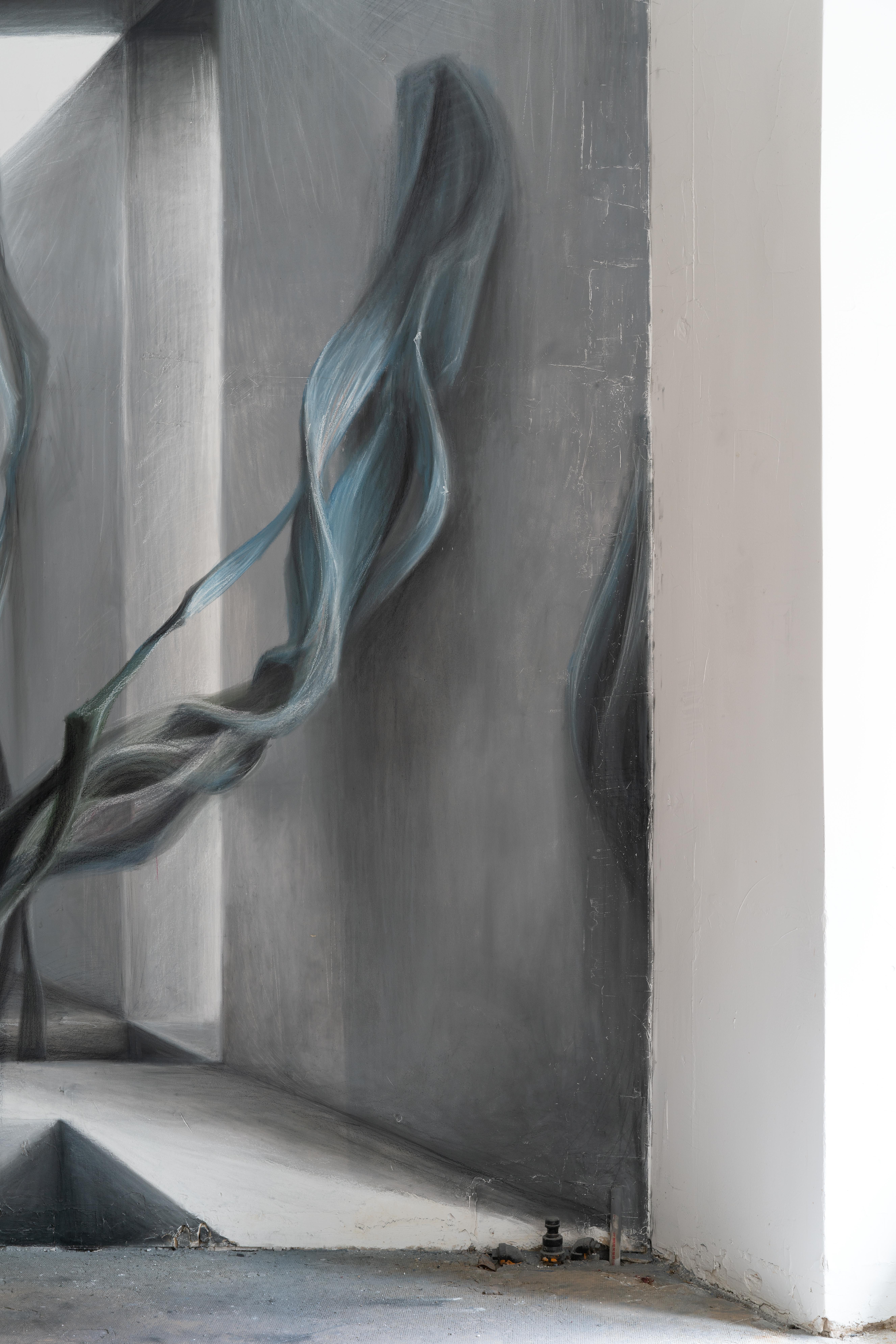
Viktor Timofeev, Godflower XIII (2021). Installation view at DRONE, New York. Hard pastel on wall. Courtesy of DRONE, New York.
I think it is also relevant to mention that I regularly work in different media in tandem, and don't establish a hierarchy between them. This network resembles something like a tree with asynchronously growing branches—I will work on a digital project on one branch, bring it to a dead end, and go back to a branch revolving around works on paper and “grow” that for a while. This is maybe why my recent exhibitions have settled into installations consisting of interdisciplinary works—they are like snapshots of the current state of this one big tree. As this tree grew larger, I felt a need to keep track of how its “roots” communicate with its “leaves”—how core themes mutate out to different ends from a single seed (sorry for the extended botanical analogy).
To this end, I started making visual charts that map connections between different branches in my practice, resembling mind maps. These developed to look more like forensic, conspiratorial evidence boards and eventually grew into a branch of their own, mapping entirely fictional relations. Ultimately this is something that happens a lot—a tangent born out of function turns into a new chapter or “branch.” The most recent charts contain so many mapped connections that the document itself is impossible to read—kind of like a really dense GUI (graphical user interface) that obscures your view of what it is describing. This kind of paradoxical humor is also pretty “Viktor-world”.
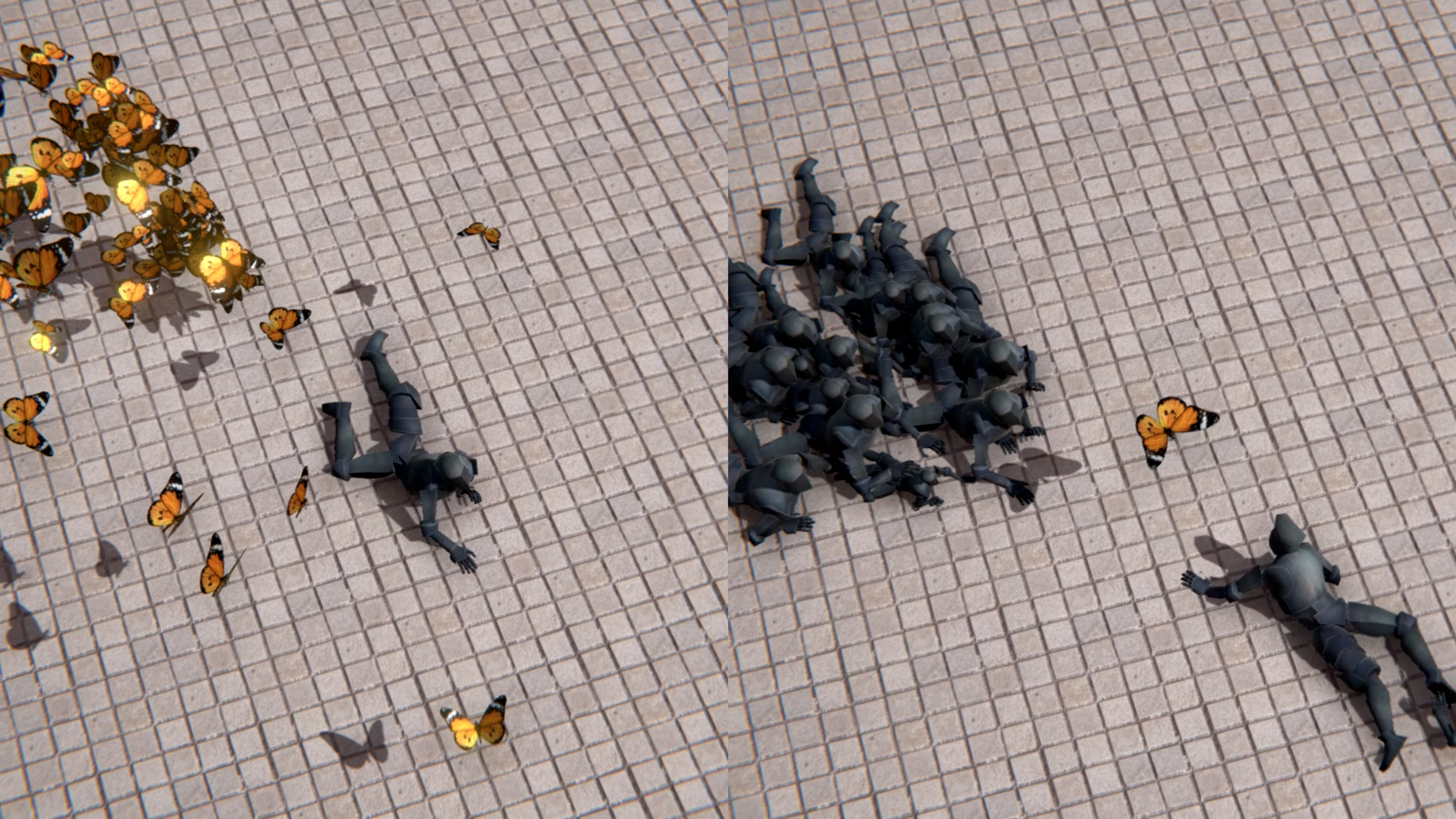 Viktor Timofeev, Twodom (2018–ongoing). Two-channel custom software, infinite duration. Courtesy of the artist.
Viktor Timofeev, Twodom (2018–ongoing). Two-channel custom software, infinite duration. Courtesy of the artist.
ES: Your work Twodom (2018–ongoing) tackles questions of animacy. The two-channel video of ragdoll meshes clambering towards a group of butterflies and vice versa tests out all possible outcomes: four day/night cycles during which the entities encircle one another, but with different outcomes each time (both human and butterfly escape, neither escapes, one escapes, both die, one dies,). It’s hard not to think about these broadcasts, these alternative potentialities, as matters of subverting the framing of an object and subject relation.
VT: Yeah that is spot on. The Twodom piece presents two alternate realities side by side, in which the protagonists are inverted. These characters perform the same choreography in both worlds—a meandering cat and mouse game, but to different ends. One is quite terrifying—a lone Monarch butterfly being pursued by a group of zombie-like humanoids—and the other is comical: a kaleidoscope of butterflies (the official name for a group of them :)) swarming around a single human. I catch myself empathizing with the butterfly, but also rooting for the humans. As a viewer you have to pick a side to watch. That's why I wanted to present these worlds side by side, emphasizing the flip side of the narrative. There is no single version of this work as I am still processing through all of the options. There is a version that is infinite, and a few that last only some minutes. The version above ends in a lose-lose scenario in which both protagonists are “captured.”
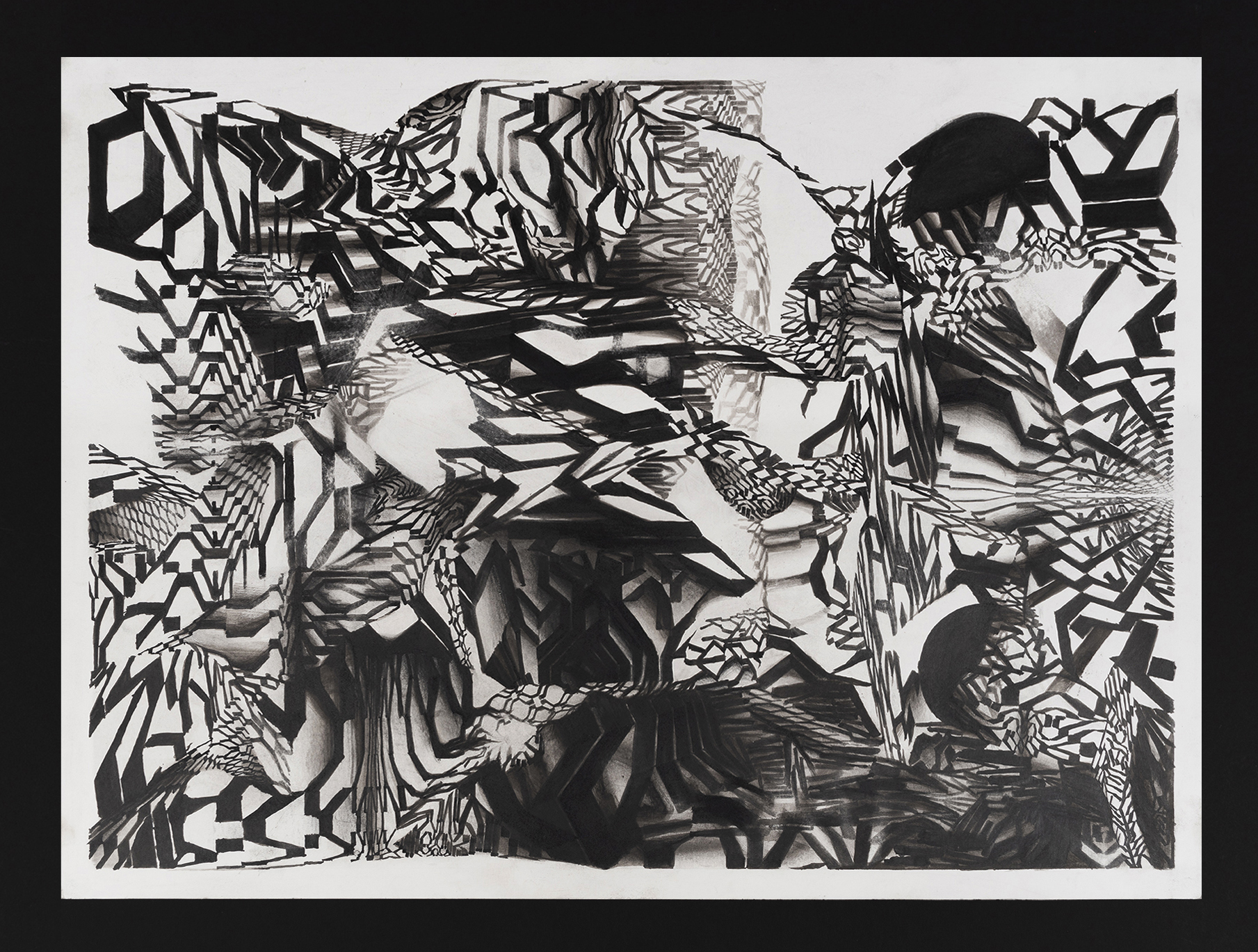 Viktor Timofeev, Selenophilia Album (2022). India ink, charcoal on paper in artist's frame. Courtesy of the artist.
Viktor Timofeev, Selenophilia Album (2022). India ink, charcoal on paper in artist's frame. Courtesy of the artist.
This thinking was inspired by the worldbuilding present in China Miéville's novel The City & the City, about two cities that share the same time and space. The cities are occupied by two warring populations that are forbidden to see and communicate with each other, even though their lives are cross-hatched together. In this narrative, there are two opposite perspectives cohabiting the same plot of land. This idea also inspired an earlier work, Four Characters In Search of a Random Exit (2018–2021), that used some of the same digital assets as Twodom. Four Characters is also a self-playing game, but I think of it more as a choreography of game characters. That work also uses a split screen, but instead focuses on the divide between first-person (subjective) and third-person (objective) perspectives. We see each of the four characters from above at the same time as their worldview in first person. Needless to say, these perspectives diverge.
ES: I’m often thinking about how parafiction is not a glitch in the creation of geopolitical reality; instead, it is a fundamental tool of its formation (considering our current geopolitical situation, which we’ve discussed ad nauseam). To that end, how do you consider a user/viewer/player would be affected by this negotiation—by the “opposite” perspectives (or doubled realities) on display? Making work that is so much about a dynamically changing set of agencies…
VT: To different ends, this idea of multiple perspectives has been present in almost all of my game-related projects. The ability to work with an infinite number of cameras is unique to this medium and speaks very much to the overall interconnectedness of things. It makes me think of causal relationships within an ecosystem and how much of contemporary life is built around hiding these systems from view. I find it easy to forget that as an individual, I suffer from main character syndrome. I see everything from a first-person perspective and experience a singular and empirical reality. But there is so much missing there! Making these pluralistic little microcosms is my way of working through that and passing it on to a viewer. But more specifically about agency, my thinking is actually related to a different story.
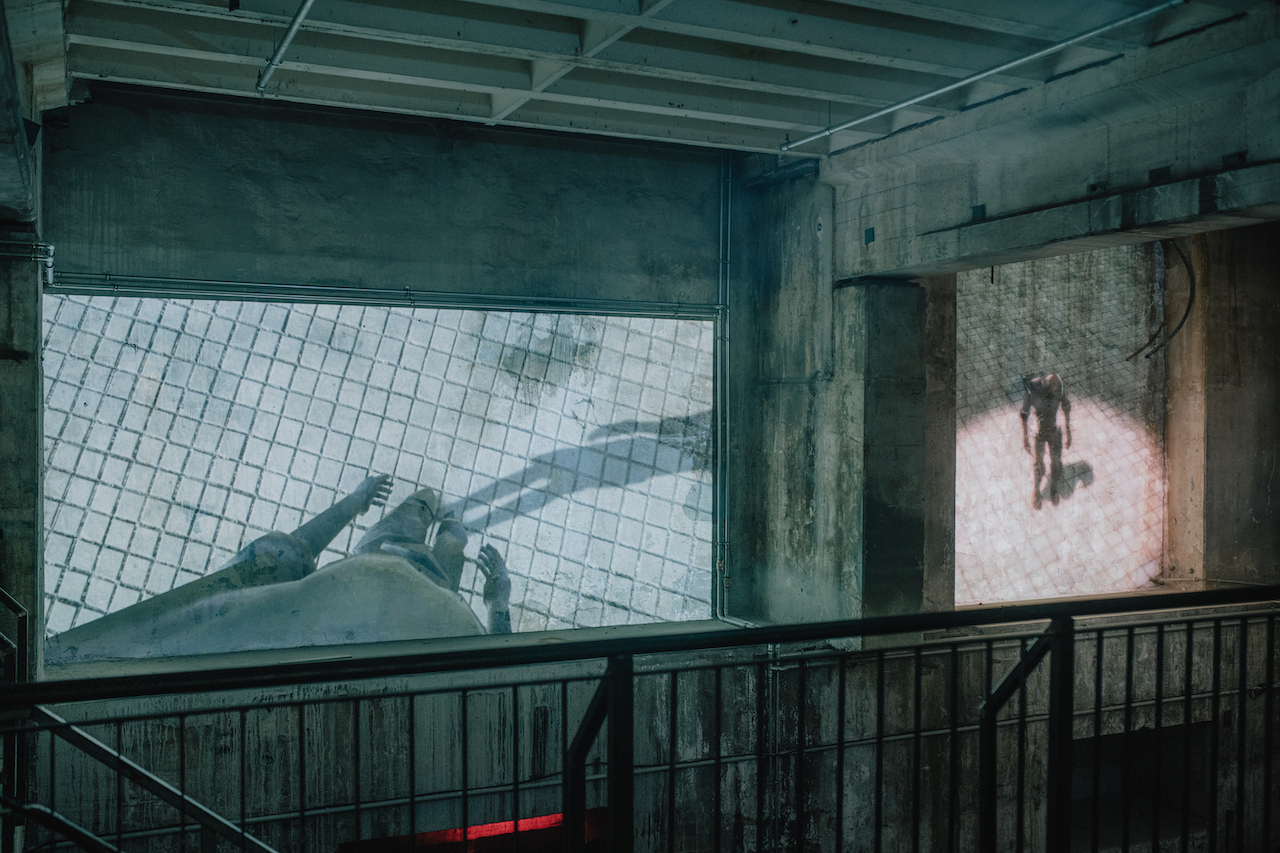 Viktor Timofeev, Four Characters in Search of a Random Exit (2017-2021). Installation view at Kraftwerk Berlin as part of “Atonal Metabolic Rift.” Two-channel custom software, infinite duration. Courtesy of Berlin Atonal.
Viktor Timofeev, Four Characters in Search of a Random Exit (2017-2021). Installation view at Kraftwerk Berlin as part of “Atonal Metabolic Rift.” Two-channel custom software, infinite duration. Courtesy of Berlin Atonal.
While I was working on Sazarus 0 (2016), a sequel to Proxyah, I had an unexpected experience. I attended a series of performances of Yvonne Rainer's seminal early work and something new clicked in my brain. I watched dancers embody a pattern of movement that relied on generative rules, chance, and feedback. I felt like I was watching a hidden logic at work that I couldn't exactly pin down. That was so exciting. Basic pedestrian movements became charged with an unknown, task-like purpose—Why did this person run over there? Why did one person follow one, and not another? Watching another human interpret an algorithmic score felt profoundly different than encountering this in game space. I wasn't aware of Rainer's work, but fell in love with it and spent time researching and getting inspired by other choreographers and dancers from that generation. For example, I was able to draw a personal parallel from Simone Forti's work with props to my budding interest in sculptural interfaces, and was inspired to try a live action version of my in-progress game featuring instructed performers, projections, and motion sensors. The audience was able to watch the performers play the game I made, but the interaction was entirely mediated. It was my first time trying something like this, but already this setup created the feeling that I was after— that there was an obscure, interactive process on display, and the audience were merely spectators.
Inspired by this small step out of game space and in search of simple mechanical objects that responded to rules, I started to experiment with robotic toy bugs. I bought a bunch of HEXBUG toys and released them into an enclosed space. To my surprise, simple rules gave way to emergent behavior and I felt like I was watching actual creatures. Jumping back into digital space, I recreated this swarming behavior by programming virtual cockroaches to imitate this basic rule set. This laid the groundwork for Physical Capacity (2018), my first VR work. VR presented the possibility of separating the player-character from their physical reality, as they are visually fed a virtual world that no one else can see. I wanted to amplify the divide between the active player and the non-participating people in the room as much as possible. The game centered around a player who, over the course of eight minutes turns into a “bug,” or a quadruped creature. To an outside observer or a waiting audience, the player appears to crawl in random directions, leaving it unclear as to what stimuli they are responding to. In game space, the player is slowly coerced into getting low to the ground by a series of prompts—the player is rewarded for finding virtual cockroaches that populate a maze. An interesting dynamic grew out of observing both players and audience interact with the game —a hierarchy between the outside (out-of-game) and inside (in-game) world. The audience took pleasure in watching players get on all fours, while the players were unaware that they were subject to jokes.
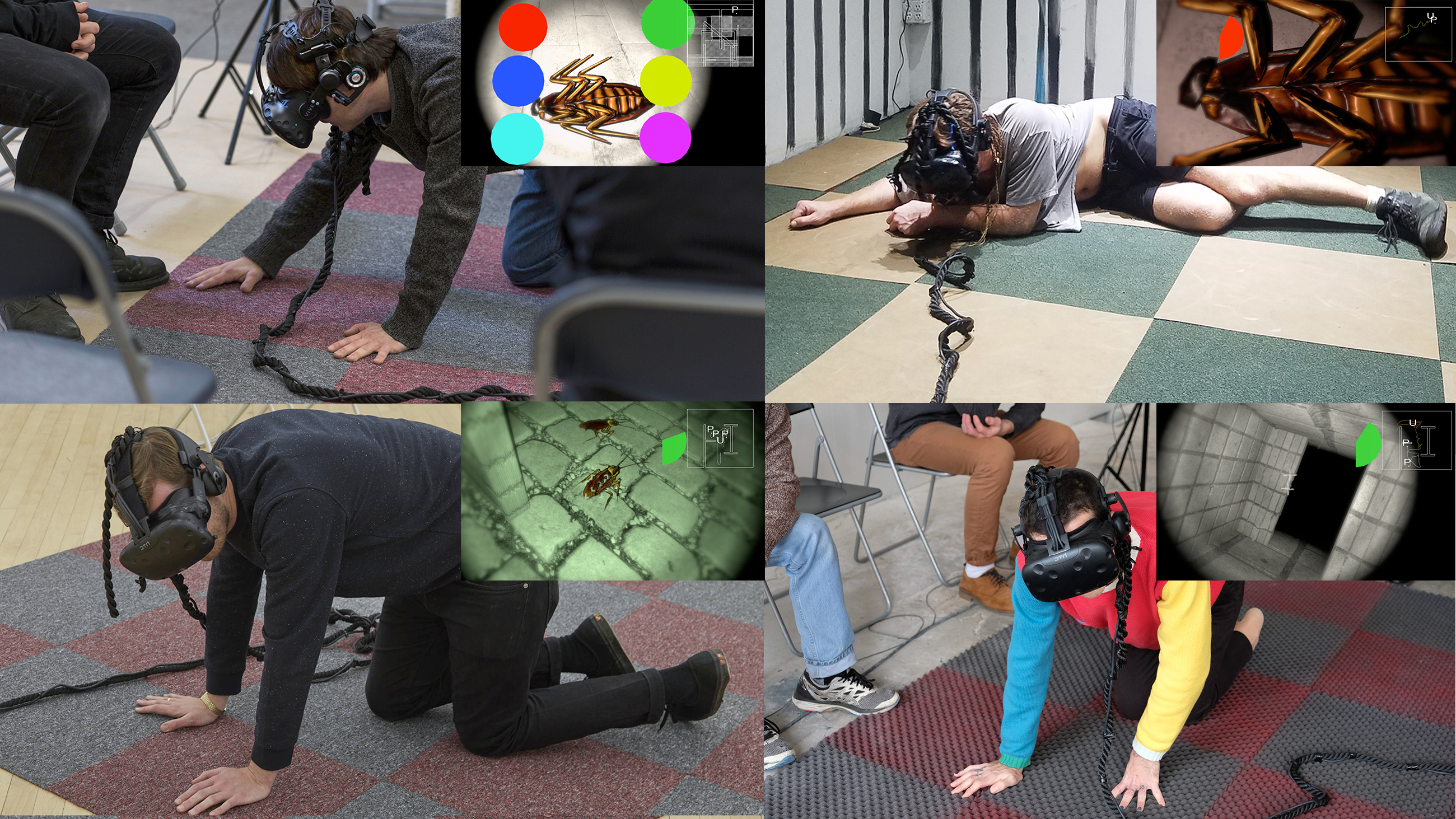 Viktor Timofeev, Physical Capacity (2017). Installation views. Custom VR software, modified hardware, furniture. Courtesy of the artist.
Viktor Timofeev, Physical Capacity (2017). Installation views. Custom VR software, modified hardware, furniture. Courtesy of the artist.
ES: What’s next for you?
VT: I'm currently finishing another episode of a collaborative video drawing series I do with my friend Jaakko Pallasvuo (who was also interviewed for a Rhizome Artist Profile). We started the project in the beginning of the pandemic as a way to check in with one another and keep our collaborations alive. We log in (Jaakko is based in Helsinki), talk, and draw for about two hours a week, sharing a virtual drawing board. I record the session on my screen and speed it up. An hour of drawing translates to roughly one minute of video, each episode is about twenty minutes, and we are currently finishing our sixth one. Every episode has a set of rules and limitations, though these are subject to being ignored or improvised upon. The entire thing is more of an animation, since our concurrent compositions are constantly in flux and we always pick up where we leave off. We are trying to organize an exhibition where we present all of them together with a single, generative soundtrack. The first drawing sessions from 2020 became a music video for a song off of my album released with Futura Resistenza.
I am really excited to take part in RTRU, a new platform curated by yourself and our mutual friend Zane Onckule. For the launch, I am breaking down the logic and sharing assets, inspirations, and sketches that underpin the aforementioned Four Characters piece. I actually think the secondary material that I collected around this piece is more interesting as an autonomous work. I am also slowly laying the conceptual groundwork for a new choreographic work with a cast of performers. The idea is to use my recent games as a starting point, but take it all the way out into real space. Stay tuned!
QUESTIONNAIRE
Age (if you’d like to share):
37
Location:
Brooklyn, New York.
How/when did you begin working creatively with technology?
I fell in love with Norton Commander when I was 10 but made my first skateboarding game in Flash when I was 15.
What did you study at school or elsewhere?
I studied Computer Science at Hunter College but dropped out and switched into Fine Art. Then I did my Masters in Fine Art at Piet Zwart Institute in Rotterdam.
What do you do for a living or what occupations have you held previously?
I am currently a visiting artist-professor at the Academy of Arts, Architecture and Design in Prague, in the class of Sláva Sobotovičová.
What does your desktop or workspace look like? (Pics or screenshots please!)
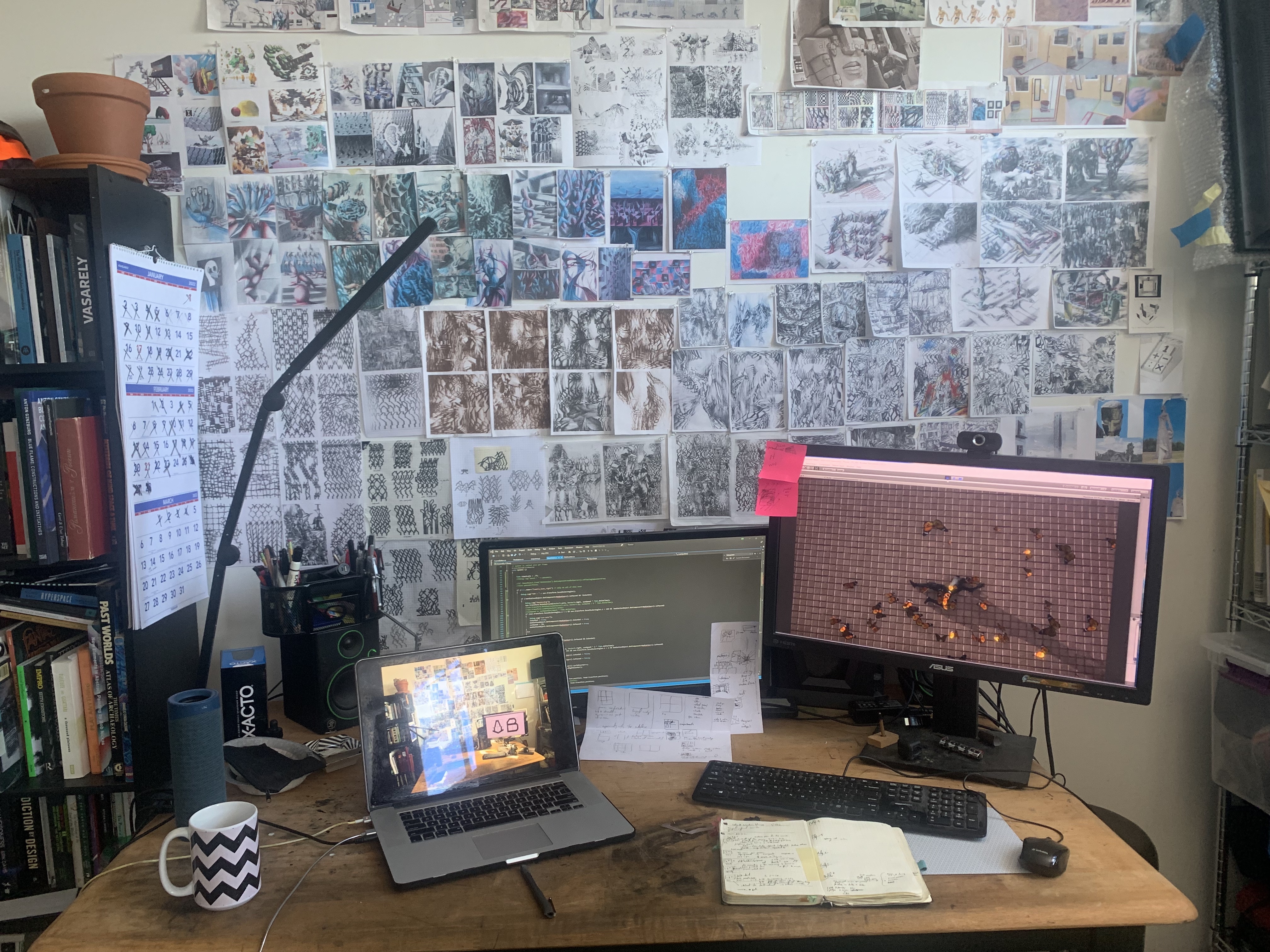
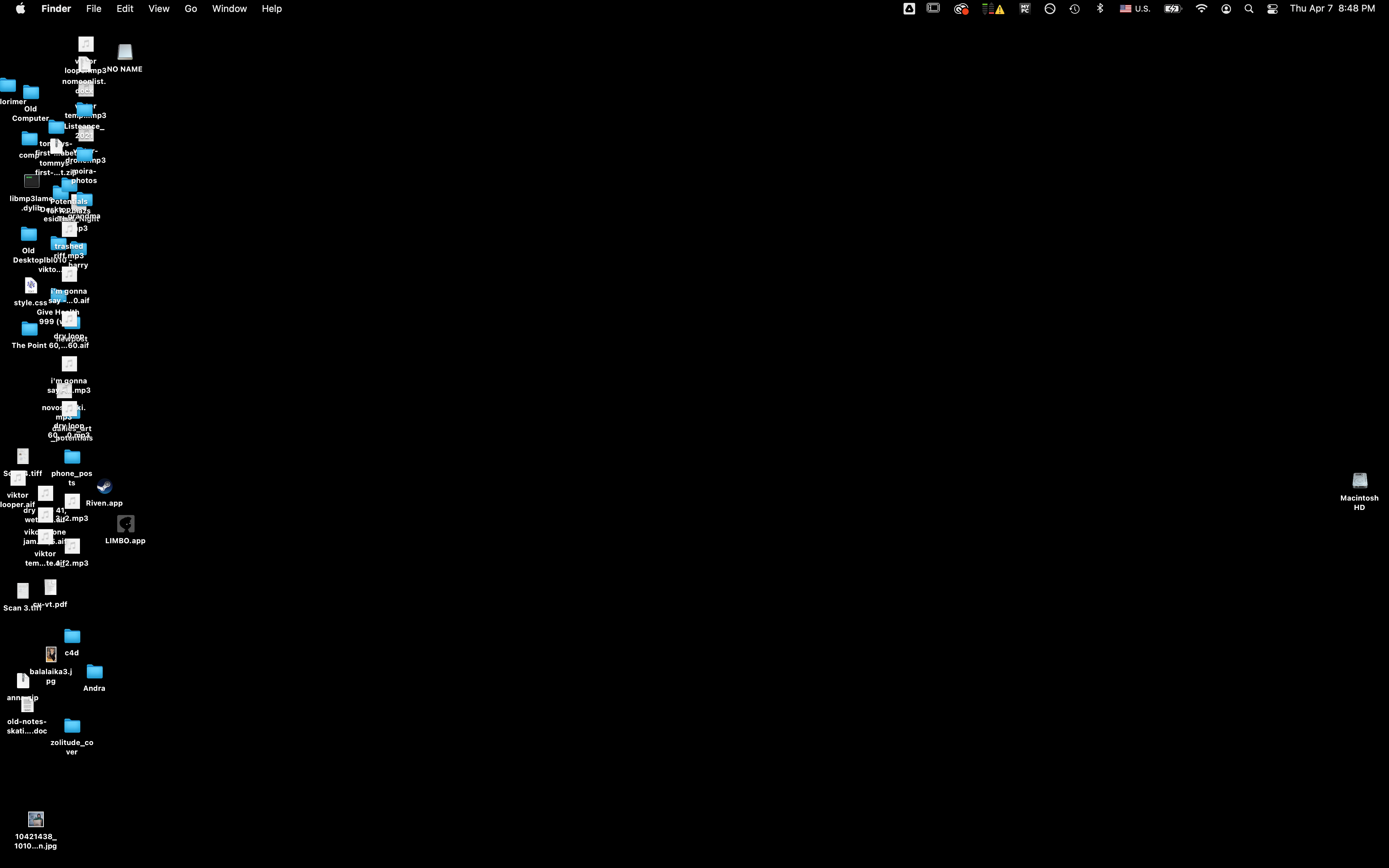
Heartfelt thank you to Elizaveta Shneyderman, Ryan Kuo, Moira Sims, Cory Scozzari.
